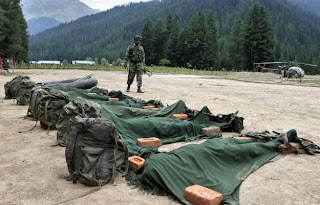Basharat Peer in Foreign Policy. Here
On a pleasant September morning, Mohammad Sidiq, a sand-digger in his early 30s, pushes his long wooden boat out onto the River Jhelum, which cuts through the heart of Srinagar, the biggest city in the province of Kashmir. As the sun rises over the blue-gray pines and bleached snows of the Himalayas circling the city, Sidiq paddles out with his partner, using long-handled shovels and corkscrews to draw sand from the riverbed. It's slow, hard work, but a day's labor nets a boat full of sand, which sells for $50. While describing the modest economy of his work, Sidiq speaks of his relationship to the Jhelum, a wide green river that flows quietly through the Kashmir Valley, across the disputed, mountainous border, known as the Line of Control, and into Pakistan-controlled Kashmir. "No man can bear what this river has witnessed," he says, staring across water.
Sidiq has been working on the river for 12 years now. Every week or two, as he hoists a shovel full of sand from the riverbed, he finds himself staring at a skull, a broken skeleton, or a shattered femur. "Most of the dead were young men. You could see their shiny teeth; you could tell from the skull, he was very, very young. One day I found a young man.... He had been badly tortured. Both his hands and feet had been chopped off," says Sidiq as he sits beneath the majestic maple trees lining the riverbank.
A fellow sand-digger in his early 40s, Naseer Ahmed, found a skull in March. "It was a small skull. It would have been a 16- or 17-year-old boy. The other day, it was a thigh with flesh still on it," Ahmed said. "It is a haunted river."
Tuesday, October 04, 2011
Kashmir,missing sons,mass graves and Justice
Subscribe to:
Post Comments (Atom)

No comments:
Post a Comment